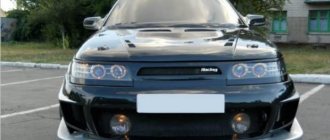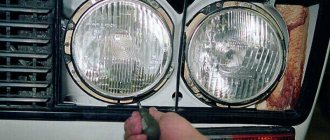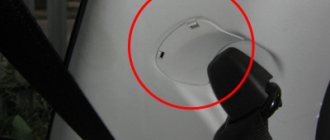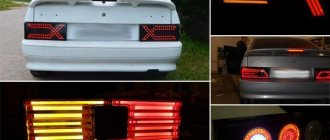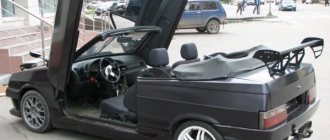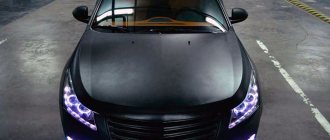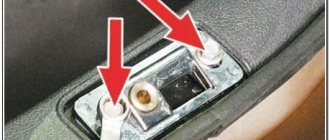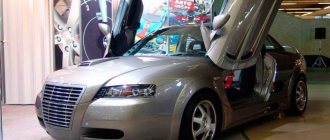Tuning optics VAZ 2113, 2114, 2115
Tuning optics is not difficult, even if you are relatively new to this matter. The main thing here is to first decide which option for modifying the rear headlights you want to use for your VAZ 2114. Today, several basic ideas are especially popular.
| Tuning type | Peculiarities |
| LED overlays | A popular and affordable option. There are many ready-made overlays offered on the market, but you can also make them yourself. To create the overlay you will need fiberglass, LEDs and epoxy glue |
| Diode rings | This modification option involves a complete replacement of the rear optics with diode rings. To manufacture them, you will need serious experience in working with electronic devices. |
| Powerful lamps | This type of modification also involves the use of a tint film for headlights. Due to the tone, bright light will be better focused. But powerful lamps have disadvantages - they increase fuel consumption, load the generator and overheat the wiring. Since the engine power of the VAZ 2114 is not high, it is not entirely reasonable to use this option |
| Individual LED elements | The most original modification option, since it allows you to express your own imagination as much as possible. But you will have to spend time and effort creating a pattern of diodes and installing them |
From a cost-saving point of view, purchasing individual LEDs will be more profitable than purchasing finished products. But in this case, you must be sure that you will be able to get high quality devices. Otherwise, it’s better not to take risks and spend more money.
• LED overlays
. Today, LED overlays are the most common option for tuning taillights with your own hands. At the same time, the vast majority of VAZ 2114 car owners prefer hand-made LED trims. There is a good reason for this - factory-made trims are not visually presentable and, for the most part, are not suitable for the lights of this car. Making LED overlays manually is not so difficult - just stock up on epoxy glue and fiberglass;
• diode rings
. Since any tuning implies the ability to work with electrical devices, making diode rings should not cause problems even for a novice auto mechanic;
• use of high power lamps
.
In most cases, this method is used before treating the glass with tint film, because the pure light of this type of lighting is too bright and can blind other road users. The effectiveness that such lamps create is offset by excessive fuel consumption and the prospect of overheating of the wiring. It is better not to use such tuning in relation to the VAZ 2114 car, since the power reserve of this car is below average; •
DIY installation of individual LEDs This method is the most creative; it opens up a wide field for imagination. Among the disadvantages is the extra time spent, which will inevitably entail developing a design and installing the LEDs themselves on the lights. One of the advantages is the reduced cost of separately purchased LEDs.
Ideas for tuning taillights
Many car enthusiasts want to make their car stand out by tuning its taillights.
Stickers and powerful lamps
One of the easiest ways to give your car an original look is with taillight stickers. Of course, these are not major changes and are more like child's play, but they can give the car an updated look.
A stylish and presentable appearance of a vehicle can be achieved using LEDs. With their help, you can give your car an original look, implementing the most daring design solutions.
Tuning includes the installation of powerful light bulbs in the optics. They are installed with a tinted film that darkens the rear light lens (the author of the video is House of Films).
An affordable and popular way to give any car model an individual appearance is overlays. Ready-made sets of linings are sold at the car market. You can make unique lantern covers with your own hands using fiberglass and epoxy glue.
DIY LED installation
Replacing lamps with LEDs consists of the following steps:
- First you need to remove the headlight. The removal tool can be a burning device to obtain an even seam.
- Next, you can remove the turn signal reflectors and take out the reflectors.
- At the next stage, the rear lights are disassembled.
- Markings are applied to the outer surface to place reflectors.
- Circles with a diameter of 15 mm are cut out of self-adhesive film and glued inside.
- The surface inside the stops and dimensions should be painted silver. When the paint dries, the circles should be removed.
- We install reflectors using epoxy glue. All joints should be coated with sealant.
- Pre-prepared boards with LEDs are installed in the case, and the wiring is connected.
- Assembly is carried out in reverse order. The parts are attached with glue.
- At the final stage, the operation of the optics is checked.
Thus, knowing how to remove a tail light, you can replace conventional light bulbs with LEDs. LEDs are also installed in the rear running lights.
Tail light covers
You can make your own covers using fiberglass. To do this, masking tape is first glued to the rear lights, then fiberglass, which should be impregnated with epoxy glue. All irregularities must be smoothed out and the layer must wait until it dries. It is recommended to apply several layers.
After 10-12 hours, the blank can be removed and the contours of the future product can be drawn on it. Then the profile is cut out. The resulting parts should be puttied, sanded with sandpaper, coated with primer and painted. At the final stage, the overlays are varnished. The covers are attached to the rear lights using double-sided tape.
Important step
Why is replacing optics in a car an important and responsible process? Because for the slightest violation (if, for example, the headlights are too dark), a fairly decent fine is provided.
That is why before starting work, it is worth carefully studying the depth of darkness. That is, if the car owner has a luxurious white car, then black optics will not always be in place.
And indeed, if you look closely at a variety of photos of headlight tuning made by yourself, you will notice that they do not go into too black shades and tones.
The best option (for any make of car) is to use a dark shade on some small area of the headlights.
Most often, experienced craftsmen recommend changing only the top line located along the cut of the hood. Then the optics will look different, it will be slightly narrowed, which will give it more style.
LEDs as an impetus for development
With the advent of LEDs, the development of tuning rushed forward sharply. More and more new and unique solutions began to appear; no other light bulbs can achieve such a visual effect as diodes.
Using LEDs you can decorate the interior, doors, and optics. If it is now fashionable to install so-called angel eyes in front, then special elements based on diodes are most often mounted for the rear lights.
LEDs
LEDs have not only decorative, but also practical properties. Due to them, safety increases, since the level of luminescence is higher. But most importantly, such an option for modifying optics is permitted by the legislation of our country and not only that.
Search form
We will talk about modified nines. These lights are much more reliable and beautiful than regular headlights. In some cases, they may even be numbered at the end of the block. Coolant temperature indicator VAZ
Often, in the event of a voltage drop, it may be necessary to remove and replace fuses.
Thanks to this, electrical wires can be directly connected to existing electrical circuits. The luggage compartment has become more spacious and convenient due to the increase in the trunk lid. Instrument lighting switch.
We pay attention to the normal fit of all parts of the housing, the absence of play or the pressed brass contacts dangling in the sockets, we check the threads and the condition of the fastening screws on the terminals. The new heater design provides efficient heating of the interior.
If the procedure is carried out incorrectly, it will create new problems. Windshield wiper relay for VAZ Front and rear headlights are glitchy - Scheme for turning on headlights for VAZ-2113, 2114 and 2115 (Discard relay K 4)
Typical faults and methods for their elimination
There are many reasons why taillights may fail or partially not work, but the main one is failure of the flexible printed circuit board. This is, in fact, the most sore spot of the rear light devices of the VAZ 2115.
Often, flimsy contact pads that pretend to be light bulb socket contacts fail, although in fact there are no sockets in the flashlights - a plastic ring that fixes the light bulb, a plastic pressure pad (all with latches) and contact pads on the board. It couldn't be simpler, but funnier too.
The service life of such a “cartridge” is six months maximum. Considering that the car was produced for 15 years, then this approach of the developers to the flashlight, the design of which has not changed over all these years, is surprising, to say the least. But the fact is clear.
Converting the board to cartridges
You can, of course, regularly change the flexible board - this is not a problem. But, firstly, the board costs money and, in principle, should not be a consumable item in order to buy it in packages. And, secondly, when someone is dead, for example, you won’t immediately notice “stop”, which means that at any moment we risk getting “in the butt” in the literal sense of the word.
Therefore, it’s better to tinker and do what the VAZ designers should have done a long time ago - replace all this flexible hack with normal cartridges. So, we go to the store, buy three ordinary plastic lamp sockets: one for a single-helix P21W, two for a double-helix P21/5W lamp. They are practically the same in size and appearance.
You will also have to buy a set of four-pin male-female car connectors. The photo below shows only an option, but there are many types of such connectors. In addition, any others for a larger number of contacts will do.
How to disassemble the rear light board? Elementary and without any tools. For speed, you can use an awl, the tip of a knife or a screwdriver, but you can do everything with your bare hands. We press the latch (photo on the left) and pull out the plastic imitation of the cartridge. Everything else will fall apart on its own. We remove all three cartridges.
We completely disassemble the panel - remove the plastic lamp clamps, remove the flexible board. We mark places for new cartridges, while focusing on the position of the old ones.
We remove the mounting posts for old cartridges and everything that interferes with the installation of new cartridges using, for example, a soldering iron. We drill holes of such a diameter that our new cartridges fit in there tightly and do not dangle. If there is no appropriate drill, drill with a smaller diameter, then bore with a round file.
For the turn signal bulb we use this socket - it takes up less space, but you can put another one - just cut it a little (however, this one also had to be cut a little).
We install the cartridges in their places and fix them in any available way. In the photo below they are simply soldered with a soldering iron. Not exactly aesthetically pleasing, but reliable. But this “aesthetics” will still not be visible. We take out the wires of the “turn” cartridge through the hole made.
All that remains is to solder the connectors: – one – to the light bulbs, the other – to the flashlight power harness, having previously cut off the old one.
We install the board in place in the lantern, connect the power supplies, and check.
Modified board installed in its original place
The cartridges we have chosen are, of course, optional. This is how the author of the photo below came out of the situation. He used metal cartridges.
Replacing the power connector
Sometimes the sockets in the rear light work like clockwork, but the connector, which is integral with the flexible circuit board, fails. If you don’t want to work on installing cartridges, you can solder a regular block to the board tracks, and replace the standard block on the power harness with its mating part. The idea itself looks like this:
The photo above shows a modification of the flashlight for the VAZ 2114. For our 2115, everything looks the same, only there will be 4 wires, and the block can be taken with 4 contacts, and not 6. Well, it would be nice to protect the soldering area from moisture with a sealant or hot glue gun.
Operating modes of LED optics
If you decide to install LED headlights yourself, then it will be useful for you to learn about the operating modes of this type of optics.
Depending on the manufacturer, the optical control unit may have several operating modes:
- urban;
- bad weather mode (rain);
- all-weather mode;
- high speed;
- as well as the mode for driving through complex intersections (the author of the video is Big Test Drive).
As a result, in order to adjust the level and position of the light beam, it is not necessary to completely change the lighting angle. To do this, it will only be enough to turn off those few diode elements that blind the driver of an oncoming vehicle. You will not suffer from this, and the driver of the oncoming car will not be “blind”. It should be noted that the Audi automobile concern recently tested various adaptive light systems, and the results of these tests were interesting.
In particular, a dull darkened spot clearly covered exactly the area where the control unit detected the oncoming light beam. And even if this beam moved in different directions, the dark spot followed it without slowing down. Moreover, this did not affect the quality of the light beam of the vehicle in any way. The shadow simply covered the oncoming light, but at the same time, the sections of the road necessary for the motorist were always well lit.
Of course, the Audi company produces only high-quality lighting systems, you can’t argue with that. If you opt for cheaper Chinese options, then the situation here is somewhat different. Firstly, such systems can be equipped with only a few mode functions - for example, only all-weather and rain or rain and city. Secondly, on cheaper options the quality really leaves much to be desired.
It is not a fact that a “smart” control unit that automatically adjusts the direction of the light flux will be truly smart. Therefore, when choosing optics, it is better not to opt for cheap options - after all, we are talking about the safety of the person behind the wheel. In the video below you can see what the tuned headlight optics on a Lada Priora car looks like (the author of the video is Alexander Kuleshov).
Functional purpose of devices
To make a homemade LED flashlight for a car, you must first of all know the purpose of this device. Otherwise, the new tuning may not meet the functional responsibilities of the lighting fixture. The rear lights of a car are part of the vehicle's lighting system. At the same time, they perform a number of functions, which include the following points:
- when driving in reverse, such headlights provide high-quality illumination of the road surface;
- inform other traffic participants driving behind the car about its presence on the road surface in bad weather conditions, as well as in the dark;
- informing behind driving motorists about the driver’s intention to turn left or right;
- transmitting information to other drivers about an accident or vehicle stop.
Car at night on the road
To perform these functions, the rear lights will always be painted white. In addition, they have a much larger beam of light than brake lights. This device combines such lighting devices as:
- stop signal;
- turn signals;
- marker lights;
- reverse signal.
As you can see, the taillights are a total lighting installation. It is placed on any machine symmetrically and in pairs. Very often, such a headlight is a single unit, which includes all the lights and signals listed above. Somewhat less commonly found in vehicle configurations are lights consisting of two blocks. They are installed on each side in pairs. As a result, not two, but four lighting fixtures will be installed at the rear of the car. Many modern vehicles have a diode tail light, namely its turn signals. But not all domestic cars can boast such modern taillights. Therefore, many car owners prefer to do such tuning themselves.
Step-by-step assembly instructions
To assemble a diode tail light with your own hands, you can use various instructions. Let's consider the simplest and cheapest option for making such a lighting installation with your own hands, based on the use of an LED ring. For this we will need the following materials:
- red diodes with a diameter of 5 mm (64 pieces). You can take medium brightness;
- for stops – 20 LEDs with increased brightness;
- resistance (120, 150 and 270 Ohms);
- 12 V power supply – needed for testing;
- a can of matte black paint;
- 4 pieces of plastic. They should be even;
- 4 voltage stabilizers, which will be used for dimensions.
Tools you will need:
- screwdriver;
- glue gun;
- wire cutters;
- knife;
- heat shrink;
- soldering iron;
- tester;
- technical hair dryer.
Step-by-step instructions for assembling the lantern are as follows:
- We cut off the glass from the old headlights. To do this, it must be constantly heated with a hair dryer;
- Next, we take out the light diffusers and paint the reflectors black;
Headlight without diffusers
- then from a piece of plastic we form a platform for placing LEDs in it and implant the LEDs into it;
Note! LEDs can be placed on a plastic base in a variety of ways. In this case, a circle was chosen.
Prepared plastic platform
- We solder the leads from the standard headlight sockets to the LEDs and connect them to check that the light sources are connected correctly;
- We solder stabilizers into the electrical circuit;
Soldered circuit elements
- We put a reflector painted black on top of the diodes;
Working LEDs
- we install all the components of the lamp in place;
Reinstalling the LED backlight
- After that, glue the headlight glass back onto the sealant. The sealant takes a couple of days to harden;
- Next, we remove the bumper and under it we find the guides with which the headlight is held on it;
- carefully screw the headlight into place, having first connected all the wires.
Finished tuning result
The steps described above must be repeated for all lights that are located at the rear of the vehicle.
Removal, disassembly and tuning
We have figured out the design of the lantern and its circuitry, we know how to change light bulbs, now we will try to make a little tuning of these lighting devices. But first, let's learn how to remove the lantern, disassemble (more precisely, break) and assemble (i.e., repair).
Removing the rear light
We open the trunk lid, find a pocket in the upholstery that covers the back of the lamp, and open it. We remove the power supply, take out the board with the lamps. All these steps are described in detail in the “How to replace lamps” section. We bend the upholstery along the edges of the lantern and find 4 nuts located around the perimeter. In the photo below, two of them are marked with arrows.
We unscrew them with a key 8. Pull the lamp in the direction of the arrow in the photo below, remove it from the body.
Disassembly
Like most previous VAZ models, the rear light on the 2115 is non-separable, so we’ll break it. The most common option is to simply cut the glass around the perimeter. The author of the next photo used an angle grinder for this.
We walked along the perimeter, where we couldn’t reach with a cutting wheel, and used a piece of a hacksaw blade for metal. Carefully pry up the glass with a screwdriver and, with a little force (in one place it is glued to the edge of the body, which cannot be reached with a saw), disconnect it.
Healthy. Instead of a grinder with a huge disk, it is better to use circular attachments on a drill attached to a conventional drill. Such attachments cost around 300 rubles and are always useful on the farm.
Assembly
Of course, we will assemble the flashlight after tuning, but we will place this item next to disassembly. We assemble using a soldering iron and sealant. We apply the glass to the body, grab them together with a heated soldering iron at a dozen points - just so that the structure does not fall apart.
Now we carefully go around the perimeter with a soldering iron, soldering both parts of the lantern together so that it is not only strong, but, if possible, airtight.
Well, to ensure that moisture does not get inside the lantern, we coat the seam with sealant.
Once the sealant has dried, the rear light assembly can be considered complete.
Tuning
Let's look at a simple but very interesting way of tuning rear lights. Its beauty is not only in its simplicity, but also in the wide choice of appearance of the lighting device and at the same time in the extremely low price of the work. We will only tune the brake lights/dimensions, but if desired, the same can be done with the turn indicators or fog lights (you can disassemble the internal rear lights using the same algorithm).
The essence of the method comes down to the following: we cut out an overlay from thick cardboard that repeats the size of the side light window. In principle, there are two such windows in each lamp on the VAZ 2115, but we will make one out of two by cutting off the aluminum partition separating them on the body reflector.
In this overlay we cut out whatever we want. Look at several methods and, if desired, repeat them or cut out your own.
And then we have two ways - grab these masks to the glass with a glue gun or paint the glass from the inside according to a template with opaque red paint. Red - so that the mask is not visible from the outside when the lamps are off. You can paint either the cut out parts using a cardboard template as a stencil, or vice versa - mark the cut out places with a marker, remove the template and paint over the rest. If we leave the masks on and not paint them, then, naturally, they should be red so that they do not show through.
Budget tuning of rear lights of Daewoo Lanos with your own hands
Hi all.
Today I will share with you one rather interesting and very budget-friendly way to tune the rear lights of your car. Daewoo Lanos will act as a test subject; all work will be carried out at home using available materials. Task. The goal of this experiment is to create headlights in the style of new cars that use LED optics, like the new Audi and Volkswagen. But, since we will do everything at home and the main thing for us is “quickly” and “inexpensively”, we use a minimum of materials and means.
What do we do?
To achieve the appearance of the lights like those of modern cars, paint will help us, which will darken areas that should not be visible. As a result, only some parts of the lights will glow, thereby creating the illusion of LED optics. Of course, it will not be possible to achieve a 100% match, since Lanos is not an Audi, however, as for me, after such tuning, the headlights began to look more individual and modern.
What is needed for the job?
- Masking tape, for gluing areas that cannot be painted.
- 1-2 cans of spray paint to darken areas that should not be visible.
- Household hair dryer, in order to disassemble the headlight unit.
- Soldering iron for removing excess partition.
- A little LED strip that will replace the standard light bulbs.
How to tune the rear lights on a Daewoo Lanos?
- First of all, we dismantle the lights; this is done quite simply, so I won’t describe it.
- Carefully, so as not to melt the plastic, we heat the headlights until the sealant softens and allows the glass to be removed.
- Next, carefully, so as not to damage the headlight, using a soldering iron or knife, cut off the vertical partition of the fog lamp. This will provide us with a uniform glow, filling the entire headlamp with light.
- Create the required shape of the glow. Your task is to come up with the shape and outline of the luminous elements of the headlight; for this you need to cover with masking tape those areas that should not be painted, and paint the pasted areas evenly in several layers. You can have your own form, or alternatively you can use my template. The most important thing in this matter is to maintain proportions so that both headlights have the same pattern. To do this, you can use anything; alternatively, you can create an exact layout on a computer, then print it on a printer.
- Also, do not forget to tape the front side of the glass with tape; during painting, this will avoid unnecessary problems.
- When everything is prepared, we start painting. We paint with a spray can, in four layers, let it dry between layers, the paint is silver metallic.
- Upon completion of painting, let the layers dry completely and carefully remove the masking tape and adjust the shape if necessary.
- If you don’t want to mess around with the LED strip, you can just start assembling the headlights. For those who want to achieve better results, I recommend being patient and not rushing.
- We take the tape, cut off small pieces and glue them onto the painted areas with double-sided tape. For those who are worried that it won’t fall off, you can play it safe with hot melt glue or another reliable analogue. We glue several LEDs, you don’t need too many, the light will be quite bright.
- We connect our LEDs, check the operation, and then assemble the headlights according to the same principle as we disassembled. We warm the sealant and gently press it and wait until it sets. For reliability, you can put your own sealant, which will strengthen the strength of the seam.
A little trick! In order not to be left without stops one day, I recommend not completely removing the standard lamps from the headlights. Instead, they can simply be muffled by placing a little insulation, such as electrical tape, under the contact. In this case, if something happens to the tape, you can quickly and without any problems solve this problem.
You see the result. As for me, it turned out pretty good and very budget-friendly! In general, they glow in the dark very effectively and are “expensive” in the budget sense of the word ;-). Thank you all for your attention, see you again at FaraInfo. Bye.
How to make a diode ring
In order to make a taillight based on a diode ring, you will need the epoxy-based adhesive mentioned in this article. The basis for creating a lighting device will be the diode rings themselves or the LED strip. The headlight housing will be made from large or small reflectors, which are quite easy to find on the market if desired. You will also, of course, need paint (you can choose based on your personal aesthetic preferences). Most often, to work with VAZ 2114 cars, a coloring agent with a chrome-plated tint is used.
To make a lighting device, follow this algorithm:
- first of all, mount the diode rings in tin cylinders prepared in advance (as a rule, cans left over from drinks or food are used);
- in jars - carefully cut out the holes so that they look like wells. In this case, there should be two wells: external and internal. If, for example, a jar is suitable for an external well, then the internal one can be simply and cheaply made from a painted half-liter plastic glass;
Install a cylinder for mounting diode rings in each internal well with one standard Soviet-made reflector. They, among other things, must create illumination in accordance with the standard scheme: orange conductors, white reversing lights, red fog lights. After this, a large reflector may contain a certain number of elements that will look quite advantageous inside the module. The entire remaining space can be decorated with an LED ring;
Cylinder with mounted diode ring, install diode ring reflectors. At the same time, in order for their adhesion to the body to be normal, you will need fixing ribs made of a substance such as epoxylin;
Installation of reflectors of diode glass rings can be equipped with additional surfaces, also secured with epoxylin.
LED rings on car tail lights
If this algorithm is performed correctly, tuning the VAZ 2114 can be considered complete.
The emergence of modern LED elements has led to the creation of a new stage in car tuning. Motorists began to decorate the car interior, doors and, of course, optics. If the front optics are decorated with “angel eyes,” then the owners of VAZ 2114 and other cars prefer to install LED elements on the rear lights. The taillights on the VAZ 2114 are easy to tune, but almost all of them involve the installation of diodes.
Manufacturing
Now we will tell you how you can create with your own hands the above types of LED devices intended for installation in the rear lights of the fourteenth model from AvtoVAZ.
Overlays
Let's start by creating diode pads. To work you will need the following set of tools and materials:
- Fiberglass;
- LED set;
- Stationery sharp knife;
- Paint and varnish material;
- Epoxy adhesive;
- Masking tape.
We suggest you read the instructions, which will help you understand the nuances of making and installing ready-made overlays yourself. You can use tape or similar materials to secure the elements.
- Cover the rear lights with masking tape. Then apply fiberglass cloth to the tape.
- Impregnate the fiberglass with epoxy glue, which will allow you to install the overlays into it. The glue should be applied in two or three layers, but only the layers should be thin.
- Drying usually takes about 12 hours. But still, read the instructions for the epoxy glue that you purchased and are using.
- Now remove the blank and mark the contours of the future decor. To do this, use tape or a marker.
- Using scissors, cut out the resulting profile.
- After cutting out the shapes, start puttingty.
- When the surface is dry, sand it with fine-grained sandpaper.
- Now apply a coat of primer and then a coat of paint.
- When the paint is completely dry, you can apply a protective varnish.
- Install the covers on the rear lights, after which the tuning can be considered complete.
conclusions
What do we get in the end? It is precisely that LED PTFs do not provide any big advantages over standard halogen ones. Currently I'm driving with my neighbor on. In winter, when there is a lack of current, I simply turn off the headlights (at a traffic light, for example), if I see that there is not enough current to charge the battery. At the same time, I’m not afraid of breaking my fogs in the next hole
Again, fashionable LED lighting devices attract unnecessary attention, and when undergoing maintenance, it is advisable to remove them, since a meticulous master may ask for a certificate. Again, the factory DRLs in the headlights look much more aesthetically pleasing
If you compare homemade ones with good factory copies, then there is no economic feasibility to assemble yourself, and ready-made LED PTFs for 3-4 thousand rubles apiece are worth the money. Another thing is that they ordered from China can be 2-3 times cheaper than if bought in Russian online stores. Thus, I closed this issue for myself, and I don’t plan to make any more additional lighting devices on diodes (PTF, DRL). The only thing is that I’ll probably assemble a 100 Watt chandelier.

